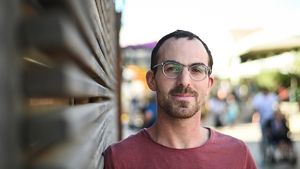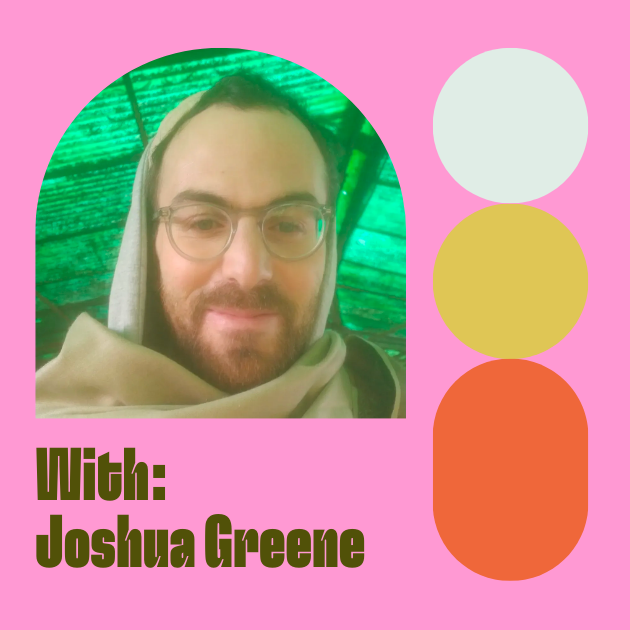One year ago, almost to the day, I embarked on a new journey: building Groove.
It’s been a happy, wild whirlwind. Looking back on this wonderful year, I’m curious to peek further back in my life, to understand how I got here and why I feel so firmly anchored in this project.
Groove’s nascent community is made up of creatives from around the world, some freelancing, some starting their own business, some working on side passion projects. We all have different paths to arriving at this search for a more social, supportive digital workspace.
Groove was started a year ago, when my co-founder Sruli and I met to discuss the problems we were facing and started to brainstorm. We both came at Groove from very different places, experiences and goals, which all combined to become what Groove is building on today.
Before partnering with Sruli, my path to find community, support and connection was purely personal. Now, with the addition of his wisdom and expertise, we are embarking on this path professionally as well.
My path to the Groove has been a journey through the worlds of meditation, the teachers I studied with, and the communities that surround them.
Part I: Starting to Meditate
Early in my career, after a string of intense projects, I found myself wiped out.
I’d lost balance. Work wasn’t fulfilling, I hadn’t quite found my tribe. My love relationship was challenging.
Searching for a way to realign — to straighten myself out — I began to practice meditation.
What started as a curiosity soon became a serious practice. After several informal gatherings in my hometown, I traveled further afield to attend a Vipassana retreat, a ten-day silent sitting, at a remote location deep in the wilds.
Silent Group Practice
Vipassana is a highly structured, closely-regulated group practice. The environment is placid, almost clinical. Attendees sit quietly from the early morning until late at night, avoiding eye contact, eating side by side without a word passing between them.
The practice was rewarding: I felt less discomfort, less suffering, noticed a growing sense of calm within myself.

For five years, I was a dedicated adherent of Vipassana, attending numerous retreats. Much as I benefited from the practice, something inside me yearned for more: more colour, more energy, more humanity. I had heard good things about the Art of Living, a global movement to support inner wellbeing through a different type of practice and community. I was drawn to explore.
I travelled to their ashram outside of Bangalore, India, to enrol in the introductory programme, learning the core practice of Sudarshan Kriya, a series of breathing exercises and meditation brought together by guru Sri Sri Ravi Shankar.
Vibrant Group Practice
The Art of Living ashram is enormous, a vast temple complex housing thousands of full-time practitioners. A place dedicated to meditation, community and service. A real, living Indian city, full of colour and sound, with free-roaming cows, bright dyes daubed on textiles, the constant burning of fragrant incense, continuous tabla music wafting through the bustling compound.
With thousands of mouths to feed, the ashram is a hubbub of cooking; the smells of cardamom and cinnamon linger in the air. At meal times you hear a raucous clash of metal food plates. Guests sit barefoot on the ground, speaking myriad languages, eating fresh dhal with their hands. It’s vibrant.
The ashram embraces two modes. Throughout the day the compound is fiercely busy, thronging with life. Then, there are times when everyone meditates, the ashram comes together as one to practice.
This coming together of many types of people from all over the world — both residents and guests — is joined by local villagers and curious farmers, housewives and businessmen driving in from across the state of Bangalore.

It is surreal to sit in a huge outdoor amphitheatre with up to 7,000 people, to hear only the fans keeping us cool, cars passing on nearby roads, and your own breathing. These times felt similar to Vipassana, that familiar collective concentration.
With one remarkable difference.
Guru as Guide
These gatherings were full of life, energy, music to create the space for meditation led by Sri Sri Ravi Shankar.
Uplifting, heart-opening music is played by around ten musicians and singers who set the tone of this ritual, inviting a fresh orientation: a shift away from private soul searching towards the hearts of others.
The Sanskrit name for this practice of intentional coming together is Satsang.
The guru, seated on a stage, invites practitioners to ask questions, to share their thoughts aloud. He listens carefully and gives an unscripted response to each question, publicly exploring the depths of whatever is presented. There is no planning; his guidance emerges organically from the needs of the group.
People ask questions. The conversation flows between Hindi, English and Kannada (the local dialect) with translation for those who need. There is a sense that one person’s question is everyone’s question.
Guided by the guru, this ashram of thousands focuses to help one individual at a time: trouble with meditation practice, worry about a child unhappy at school, a tricky love relationship. Human challenges we all share. The guru encourages the community to coalesce around these individual questions, each listener hearing their own private concerns echoed in the words of the public question.
There was something powerful about the questions not just being about meditation but life in general. It made the whole community feel more connected and more human. This reorientation to the other profoundly supports you to move beyond yourself. For each person sharing their questions, here is a palpable sense of being held, being supported, by the wider community.
This sets the tone for a guided meditation aligned with the time of day, week, or other special occasions on the calendar.
Part II: Living Satsang
The public audiences with the guru had a profound impact on me. Even if I didn’t speak to anyone else in the ashram, I never felt alone. I was a true part of the community, interwoven with everyone else, simply through my presence.
In all those years of private Vipassana meditation, I had missed something important. It seemed I didn’t only need to focus on myself in order to learn and grow. By recognising myself in others, opening myself to the collective, I could develop in a new and dynamic way. The power of the group exponentially increased my own possibility for change.
The daily Satsang at the Art of Living ashram struck me as a profound space for collective learning, in perfect synch. I wondered how I could bring this Satsang into my normal daily life.
Power of the Group
Years later, I experienced another important shift in my approach to meditation: the notion of peer-led growth.
I was invited to a retreat led by Thomas Hübl, a Western teacher trained in both the ancient Eastern traditions and the west.
Similar to other retreats, Thomas holds space for collective practice. Still, he is more focused on the power of the collective. He values Sangha, the Sanskrit word for community,as a key element in the path of transformation.
The practice on retreat is to form small groups to work together alongside the meditations. These groups of three guide one another through journeys of change. This collective approach provides more support, possibility and safety than is often possible alone.
Thomas calls this The Triad.
The Leader Within
We are lucky to have teachers, coaches and lecturers in our lives. Their example and wisdom can inspire, move us, and is necessary to light our paths.
At the same time, there is so much inner resource within each of us. We can be powerful forces in our own lives, and the lives of others when we come together to practice and support each other. We can learn to trust ourselves, rely on ourselves, tap into our own deep wells of life experience. More capable than we realise, more robust than we can imagine, we can help one another, and learn that we don’t always need an external teacher to support us.
The format of the triad is so simple: a mechanism that allows alternating turns to share, to ask questions, to explore ideas and be supported — by two others. It’s an opportunity to tap into both collective and individual support. One for all and all for one.
With a triad, we can experience the ‘belonging’ feelings of Sangha with two friends, two peers, and even two strangers.
Part III: A Pandemic Experiment
During the early stages of the Covid-19 pandemic, I panicked. With the shutting down of professional and community life, I felt a sharp jolt of isolation. I didn’t have enough support. It took me a while to articulate to myself: a need to be connected, a need to better regulate my emotions, a need for community during this long moment of global upheaval.
I was grasping for a way forward.
Then it hit me — perhaps I could try Thomas Hübl’s triad. Together, two friends and I came together for a daily meeting, five days a week, at 8:30am for half an hour.
The structure was simple. First, we meditated together for ten minutes. One of us led the process, and naturally, we alternated leadership. Then we each took five minutes to share what was going on in our lives. Whatever was alive, whatever we wanted to express. Afterwards, we sat and meditated again for two minutes, before ending the call.
This triad held us through the ups and the downs. Someone lost their job, someone had a beautiful day in nature, someone else went through a challenging chapter of their relationship. Sometimes we simply expressed aloud that we felt badly lonely, or laughed out deep feelings of joy. Whatever emerged, we embraced it.

This thirty minutes of intentional connection transformed my experience of Covid and made life feel so much healthier, more balanced. We helped regulate each others’ emotions and feelings for the day.
We’ve maintained this daily practice for the entire year, since the first lockdown. It’s important to note: we are all living our own lives. We aren’t a team of any sort, neither colleagues nor partners. We met — and continue to meet — purely for those moments of real digital connection.
Blossoming Triads
The triad experiment was working. Soon enough, I established more. With two other friends from Thomas’ retreat we started to meet weekly, in person, for two hours. In that case, what started out as a professional project has gradually morphed into a supportive working session.
I also reconnected with one of the other participants from Thomas’ retreat, who lives in Germany, and we now have a weekly triad between Jerusalem and Berlin. This triad is beautiful and blends our professional and personal lives. It happens on a friday to ‘close the week’ and provides a powerful transition to the weekend.
Throughout the early stages of the pandemic, in a sea of uncertainty, the rituals of the triad — this coming together, this regular Sangha — resonated with people in my life, providing a source of strength and joy. The space for joyful, even playful moments alongside the tough ones. Truly vulnerable and deeply human.
Birth of Groove
I was running several concurrent triads, over three or four time zones. It was increasingly clear to me that this practice had the potential to help a wider circle of family and friends.

It was so simple, anyone could begin a triad. It was easy to add new members, to set up new mini communities. Surely, this life-affirming activity could reach more people?
Then I sat down with Sruli. We had previously hotdesked side by side at WeWork in Jerusalem. Now reconnecting mid pandemic, we shared our struggles and ambitions for remote work.
Here was a meeting of the ways. Sruli expressed that he was sorely missing the community aspects of work. He asked: how could we create a virtual coffee shop? He wanted to foster the social, supportive co-working experience we both so enjoyed.
This sparked my own question: how could the triad and sangha that help me so much in my personal life also enhance my professional life?
What united Sruli and myself was a wish to connect people, to support one another, to encourage a spirit of cooperation. And it had to be fun.
We called it ‘The Groove’.
Groove’s Next Phase
While my journey to starting Groove is a winding one through the past ten years, Groove is just at its beginning.
If my path resonates with you, and you’re also trying to integrate your full self into your work life, please reach out to chat or try Groove.
We’re in the first steps of this exploration to bring human connection and support to our work lives, and I want as many people who relate to that as possible to be a part of it.
Josh is the co-founder and CEO of Groove, the first online coworking community platform that helps you feel more supported and focused so you can work with purpose. We’re on a mission to create the place that people work online.
Groove is in beta, but if you’d like to join the expanding trial and try a new way to work socially while working alone, send us a message to join our pilot.


